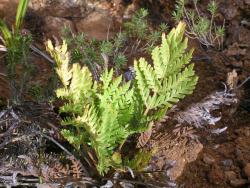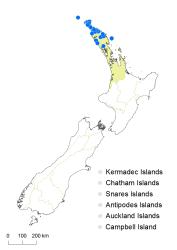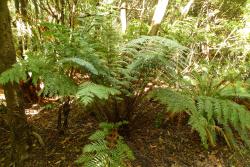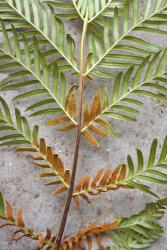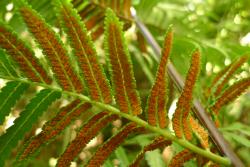- Taxon
- Gallery
- ≡ Acrostichum barbarum L., Sp. Pl. 1072 (1753)
- ≡ Osmunda barbara (L.) Thunb., Prodr. Pl. Cap. 171 (1800)
- = Todea africana Willd. ex Bernh., J. Bot. (Schrader) 1800(2): 126 (1801) nom. illeg.
Rhizomes erect, forming woody trunks up to 1000 mm tall. Fronds 210–1250 mm long, rarely up to 2200 mm in sheltered forest. Stipes 65–400 mm long, rarely up to 780 mm in sheltered forest, up to 8 mm in diameter, yellow-brown to chestnut, glabrous. Laminae 2-pinnate, ovate or elliptic, 150–750 mm long, 70–350 mm wide, rarely up to 1430 mm long and 500 mm wide in sheltered forest, yellow-green to chestnut, coriaceous, glabrous or with scattered long hairs, scented like hay when old. Primary pinnae in 11–25 pairs, narrowly elliptic, narrowly ovate or narrowly triangular, with acuminate to acute apices; the longest below the middle, 70–310 mm long, 16–110 mm wide. Secondary pinnae narrowly ovate, narrowly elliptic or narrowly oblong to almost linear, the longest 16–80 mm long, 4–10 mm wide, sessile or adnate; apices acute or acuminate; margins serrate; bases unequal, acute to truncate or adnate. Sporangia partially or completely covering fertile laminal segments, confined to proximal part of primary pinnae in proximal part of the lamina.
Todea barbara is recognised by its coriaceous, bipinnate fronds, bearing sporangia that are not aggregated into sori but completely cover the undersides of the proximal pinnae. Older plants have short woody trunks. Fronds vary considerably in size from c. 200 mm long in exposed scrub to c. 2000 mm long in sheltered forest.
North Island: Northland, Auckland
Three Kings Islands
Altitudinal range: 0–280 m
Confined to the Three Kings Islands, Poor Knights Islands and from North Cape to Whangārei and Kai Iwi Lakes, near Maunganui Bluff. It grows from sea level to about 280 m in Waipoua Forest.
Also Zimbabwe, Mozambique, South Africa, Australia (Queensland, NSW, Victoria, Tasmania).
Occurs in coastal and lowland areas, in open sunny situations, on clay banks and rocks, in kānuka and mānuka scrub, on gumland, in gullies, in swampy areas, under Pinus plantation, and in open pōhutukawa forest.
The species was given a conservation status of Nationally Endangered by de Lange et al. (2013).
n = 22 (Brownlie 1961).



